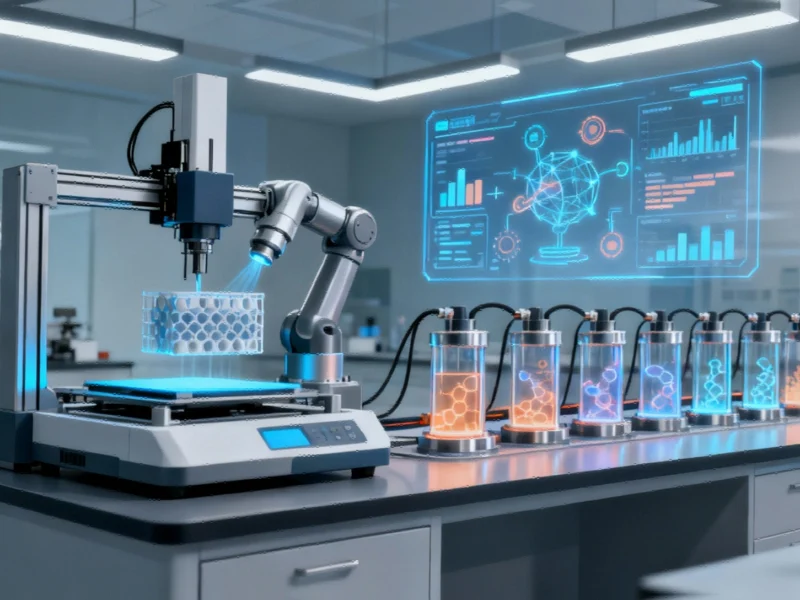Revolutionizing Chemical Engineering with Integrated AI and Robotics
A groundbreaking development from Universitat Jaume I is transforming how chemical processes are designed and optimized. The Reac-Discovery platform represents a paradigm shift in chemical engineering, reducing development timelines from months to mere days through the integration of artificial intelligence, robotics, and advanced manufacturing technologies. This innovation arrives at a critical juncture when industries face increasing pressure to develop sustainable processes while maintaining productivity.
The significance of this breakthrough extends beyond laboratory efficiency. As industries worldwide grapple with environmental challenges, the ability to rapidly design processes that convert pollutants like carbon dioxide into valuable materials addresses both ecological and economic concerns. This development aligns with similar AI-powered robotic systems transforming industrial processes across multiple sectors, demonstrating how artificial intelligence is becoming central to industrial innovation.
Technical Architecture: Three-Module Integration
The Reac-Discovery platform operates through three seamlessly integrated modules that create a continuous optimization loop. The Reac-Gen module utilizes computational design algorithms to generate optimal reactor structures digitally. This digital design phase represents a significant departure from traditional trial-and-error approaches, allowing for sophisticated modeling before physical creation.
The Reac-Fab module translates these digital designs into physical reality using high-resolution 3D printing technology. This manufacturing approach enables the creation of complex geometric structures with interconnected pore networks that would be impossible to produce using conventional methods. The resulting reactors feature open-cell architectures that dramatically improve performance characteristics compared to traditional designs.
The Reac-Eval module serves as the platform’s intelligent core, functioning as an autonomous laboratory that continuously monitors reactor performance. Through machine learning algorithms, this module analyzes reaction parameters in real-time and automatically adjusts conditions to optimize outcomes. This self-optimizing capability represents a fundamental advancement in how chemical processes are developed and refined.
Performance Breakthroughs and Industrial Applications
The platform’s capabilities have been demonstrated through several high-value chemical transformations. In the hydrogenation of acetophenone—a critical reaction in pharmaceutical manufacturing—the system achieved optimization levels that traditionally required months of laboratory work in just days. Similarly, in converting CO₂ into cyclic carbonates for polymer production, the platform demonstrated remarkable efficiency improvements.
These advancements reflect a broader trend in industrial computing, where advanced computing architectures are enabling complex simulations and optimizations previously considered impractical. The integration of high-performance computing with physical manufacturing creates new possibilities for rapid innovation across multiple industrial sectors.
Implications for Industry 5.0 and Sustainable Manufacturing
The Reac-Discovery platform embodies the principles of Industry 5.0, where digitalization, sustainability, and human expertise converge. By dramatically reducing the time and resources required for process development, the system addresses both economic and environmental imperatives. The ability to rapidly optimize chemical processes means fewer resources consumed during development and more efficient production methods once implemented.
This approach to rapid prototyping and optimization mirrors developments in other technology sectors, where compact computing systems are enabling new forms of distributed intelligence. The convergence of computing power, artificial intelligence, and advanced manufacturing is creating opportunities for innovation across seemingly unrelated fields.
Future Directions and Broader Impact
The research team’s publication in Nature Communications validates the platform’s scientific significance and potential for widespread adoption. As the technology matures, we can expect to see similar approaches applied to other complex chemical processes, from pharmaceutical synthesis to materials science and energy production.
The platform’s success also highlights the growing importance of automation and workflow optimization tools in scientific and industrial contexts. As computing systems become more sophisticated and integrated with physical processes, we’re likely to see further acceleration in how quickly new technologies can be developed and deployed.
This development represents more than just a laboratory efficiency improvement—it signals a fundamental shift in how chemical processes will be designed and optimized in the coming decades. By combining artificial intelligence, robotics, and advanced manufacturing, researchers have created a template for rapid innovation that could transform multiple industries while advancing sustainability goals.
Based on reporting by {‘uri’: ‘phys.org’, ‘dataType’: ‘news’, ‘title’: ‘Phys.org’, ‘description’: ‘Phys.org internet news portal provides the latest news on science including: Physics, Space Science, Earth Science, Health and Medicine’, ‘location’: {‘type’: ‘place’, ‘geoNamesId’: ‘3042237’, ‘label’: {‘eng’: ‘Douglas, Isle of Man’}, ‘population’: 26218, ‘lat’: 54.15, ‘long’: -4.48333, ‘country’: {‘type’: ‘country’, ‘geoNamesId’: ‘3042225’, ‘label’: {‘eng’: ‘Isle of Man’}, ‘population’: 75049, ‘lat’: 54.25, ‘long’: -4.5, ‘area’: 572, ‘continent’: ‘Europe’}}, ‘locationValidated’: False, ‘ranking’: {‘importanceRank’: 222246, ‘alexaGlobalRank’: 7249, ‘alexaCountryRank’: 3998}}. This article aggregates information from publicly available sources. All trademarks and copyrights belong to their respective owners.



